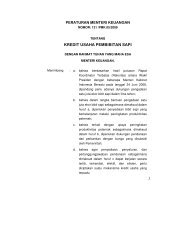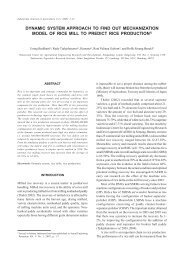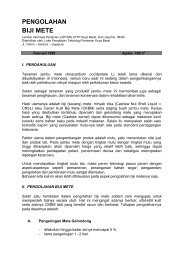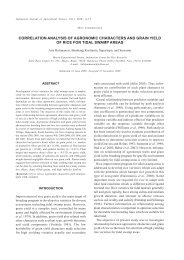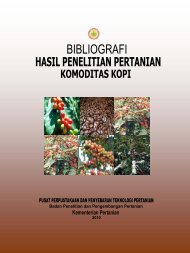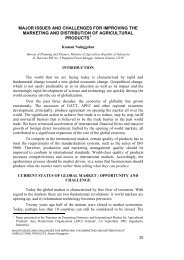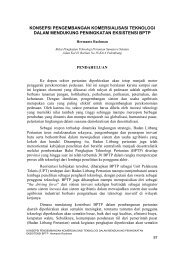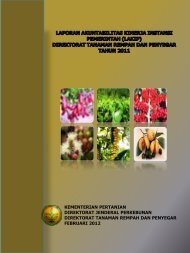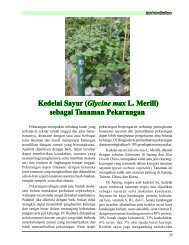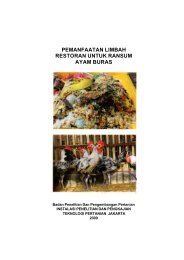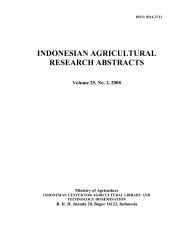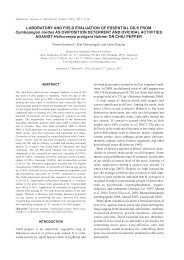3 tjeppy D..pmd - Pustaka Deptan
3 tjeppy D..pmd - Pustaka Deptan
3 tjeppy D..pmd - Pustaka Deptan
You also want an ePaper? Increase the reach of your titles
YUMPU automatically turns print PDFs into web optimized ePapers that Google loves.
ACCESSIBILITY TO SMALL RUMINANTSINPUT AND OUTPUT MARKETS IN INDONESIATjeppy D. SoedjanaResearch Institute for Animal Production, Kotak Pos 221, Bogor 16002ABSTRACTSmall ruminants (sheep and goats) are raised by most farmers using minimal input, low maintenance costs, andutilize waste products from cropping activities. They have high reproductive rate and always have a ready market,while farmers appear to be generally satisfied with relatively low levels of productivity since they are motivatedby the knowledge that these animals can be turned into cash in short notice. It is believed that increasing on-farmproductivity up to their optimum performance could enhance national development in increasing rural incomeand protein consumption. Constraints to improving the productivity include the decision to market where animalsare disposed of at incorrect time sell, nonoptimum weight and age as well as prices received, incorrect compositionof animals in each household farms, feeds and feeding practices, and little attention toward diseases prevention.Scattered production centers have created additional transportation and transaction costs to small producers totake advantage the profit margins. Market opportunities in Asia are obviously more prospective given that manyAsian countries including Saudi Arabia are small ruminant importers. However, larger enterprise has not been ableto compete with the traditional systems with minimal inputs although producing low quality but still marketableproducts. Accessibility of small ruminant farmers to market for both input and output may bring the industrytoward a more profitable, productive and efficient business. This fact could be one of the answers why effortstoward developing export oriented small ruminant production systems in the past have not been a successfulapproach.Keywords: Small ruminants, production, marketing, rural developmentABSTRAKKemudahan mengakses pasar input dan output ternak ruminansia kecil di IndonesiaTernak ruminansia kecil (kambing dan domba) dipelihara oleh peternak dengan biaya sangat minimal termasukmemanfaatkan sisa tanaman sebagai pakan. Ternak ini memiliki tingkat reproduktivitas yang tinggi dan selalutersedia pasarnya, namun peternak merasa cukup puas dengan tingkat produktivitas ternak yang masih rendahkarena termotivasi oleh keyakinan bahwa ternak ini dapat menghasilkan uang tunai pada saat dibutuhkan.Peningkatan produktivitas di lapangan hingga kemampuan optimalnya sebenarnya akan mampu mendorongpembangunan pedesaan melalui peningkatan pendapatan dan konsumsi protein hewani. Kendala peningkatanproduktivitas mencakup penentuan usia pemasaran, ketidaksesuaian bobot badan dan umur penjualan, tidak tepatnyakomposisi ternak yang dipelihara dan praktek pemberian pakan, serta kurangnya perhatian terhadap pengawasanpenyakit. Terpencarnya pusat-pusat produksi menyebabkan meningkatnya biaya transportasi dan biaya transaksi.Prospek pemasaran regional menunjukkan potensi yang besar mengingat banyaknya negara di Asia termasuk ArabSaudi yang berperan sebagai importir jenis ternak ini. Namun demikian, usaha berskala besar masih belum mampubersaing dengan usaha tradisional yang dicirikan oleh biaya pemeliharaan yang minimal tetapi memiliki kemampuanpemasaran. Kemudahan peternak untuk mengetahui dan mengakses pasar akan membantu membangun industriternak kambing dan domba yang lebih menguntungkan, produktif dan efisien. Kenyataan tersebut dapat menjadijawaban bagi pertanyaan mengapa berbagai upaya membangun sistem produksi yang berorientasi ekspor belumberhasil dengan baik.Kata kunci: Ruminansia kecil, produksi, pemasaran, pembangunan pedesaanIncreased demand for livestockproducts before the crisis wasindicated by the fact that the averagenational per capita income has grownup, and that the income elasticity ofdemand for meat, eggs, and milk havebeen high. The success story continuedin early 1990s with the establishment ofexport-led growth economy. However,small ruminant keeping is undertaken inpart to satisfy the need for a store of value,while generally inefficient compared withJurnal Litbang Pertanian, 24(4), 2005 137
production solely for the purpose of generatingthe maximum net revenue. Thisinefficiency becomes negligible whenherd size is constrained by sharply risingcosts of holding additional animals suchas might arise if the farmer faces a bindinglabor constraint. Clearly small farmerswould be better off if they had access toadequate financial institutions or couldhire all the labor they could use profitablyat a prevailing wage. But the use of smallruminants as a store of value may be agood second best solution for laborconstrainedfarmers in view of thedifficulties associated with improvingfinancial institutions in developingcountries, such as Indonesia.This paper reviews some barriersand accessibility by most of smallruminant farmers to input and outputmarkets. Small ruminant production andmarketing practices including internationalmarkets as well as institutionalarrangement are presented. Major constraintsand problems to both input andoutput markets are described to arrive atsome concluding remarks.OVERVIEW OF THE SMALLRUMINANTS KEEPINGIn many regions of Indonesia, the productionof sheep and goats is an importantcomponent of farming activity. About 90%of the sheep and 60% of the goats areconcentrated in Java, Sumatra,Kalimantan, and Sulawesi. The smallerislands have significant numbers of goats,only Sumatra has a significant number ofsheep. Since Java and Sumatra aregenerally considered as extremely denselypopulated island, the nature of sheep andgoats production is directly affectedaccordingly. For example, goats aredistributed heavily from eastern region ofJava, where Bali cattle is predominant towestern region. Similarly for sheep, whichoccupy western region of Java, andgradually lesser population found in theeastern region.ProductionThe family operated farm is typical of Javawith average range farm size from 0.20 hato less than 0.50 ha and generally consistsof both wet and dry land. Rice is theprimary food crop grown. Cassava, maize,and several species of dry land food cropsand perennial trees are also grown. Almostall farmers raise either sheep or goats andpoultry. Litter size is 1.80/ewe/parturitionand the young lambs are weaned at 3.50months. Most Javanese farmers keep theanimals confined during wet season (80%)and dry season (60%). Only 10% combineconfinement and grazing during dryseason, and 30% during wet season(Sabrani et al. 1982a). Thus, in contrast toa method of production in which grazingis the principal source of feed, and wherewe might therefore expect increasingreturns to herd size, Indonesian productionis characterized by cut and carryfor which we might expect decreasingreturns to herd size.Small ruminants are kept primarily formeat production, with sale of wool or milkbeing negligible importance in mostcases. Factors determining meat productionfrom a herd or flock, according toBradford (1993) are: 1) number ofoffspring marketed per breeding femaleper year, which is determined by fertility,parturition interval, prolificacy, andviability of the young to market age, and2) weight of individual offspring, whichis influenced by their inherent growthpotential and dam’s milk production,nutrition, and health. Because Indonesiais in the equator, breeds of the smallruminants appear to be completelynonseasonal, providing the producer theadvantages of unrestricted choice ofbreeding season and short parturitionintervals. Indonesian breeds of sheep andgoats have high levels of prolificacy.Under conditions where nutrientrequirements can be met economicallythroughout the year, uniform twinningshould be the goal. However, because ofvariation in litter size, the mean of twousually means a considerable incidenceof triplet births, perhaps 25% of all litter(Subandriyo et al. 1995).Major feed resources for goats andsheep are forages grown in conjunctionwith other crops, or grown in areas notutilized for crop production. Forages caninclude grasses, legumes, forbs, shrubsand trees that can be utilized as effectivefeed resources for small ruminant feeding.The forages usually provide the nutritionalbase for all animals. Tropical foragesare generally at a lower quality thantemperate forages. However, by harvestingthe young, immature stage ofgrowth, the quality of the forages intropical regions can be adequate for goodproduction (Soedjana and Knipscheer1982).Forages are often supplemented withagroindustrial by-products or grainsunsuitable for human consumption thatinclude those associated with theharvesting of food crops for humans (ricebran, rice straw, broken rice, crop residuesassociated with wheat, maize, millet,sorghum, and other stalks and tubers).Agroindustrial by-products according toPond (1993) are generally of low value tohumans, a waste product to be disposedof and therefore potentially economicalfeed sources for ruminant animals.Depending on the region in Indonesia,various agroindustrial by-products areavailable for livestock. Many of thesefeeds can contain either high fibercontents which may limit the voluntaryintake and lower the productivity of theanimal.MarketingMany Javanese farmers sell their animalsjust prior to the planting season to providefunds necessary for purchasing inputssuch as seed and fertilizer. Consequently,with so many animals reaching the marketat the same time, the price that the farmersreceive goes down. Farmers do not appearto take advantage of high price monthssuch as during the Islamic holidays IdulAdha and Idul Fitri due to lack ofproduction planning and incorrect agecomposition of their flock. Thus theaccumulation of animals for reasonsunrelated to either production or marketingcertainly reduces the profitabilityof small ruminant husbandry to smallfarmers (Soedjana 1982).The main outlets for farmers are thelocal markets, which are sometimespermanent, but more often take place onlyonce a week. Commercial sales are usuallymade to the village collector at the farmgate or directly to the local market by thefarmer himself. The marketing flows inJava differ from those in other country(Sabrani et al. 1982b) because the keyfigure in the village trading (the villagecollector) buys and sales sheep or goatsas a secondary activity. Sometimes hekeeps animals for fattening, or inanticipation of price hikes. The skill oftrading lies in the examination of theanimals. Traders as well as butchers138 Jurnal Litbang Pertanian, 24(4), 2005
estimate the value of an animal by sightand touch. This system of carcassestimation is by definition rather thansubjective, and therefore part of thebargaining process. Buyers may underestimatethe weight of an animal, whilesellers may overstate its physical value.Village collectors often seem to have takenover the trade from their parents. Thiswould indicate that the skill of estimationand bargaining is not easy, and thereforeit restricts the participation of farmers inanimal open market trading. It may alsoindicate a rather stable patron-clientrelationship, typical of traditional marketsystem.The village collector is the key figurein the animal market system. He buysand sells animals often as a secondaryactivity, with his skill in examining theanimals by estimating the value by sightand touch, while sometimes he keepsthe animals for fattening or in anticipationof price increases (Soedjana 1982).Furthermore, an arrangement betweenfarmers and the middlemen for paymentof the transaction showed that most ofthe village collectors pay 50% of theagreed price and than pay off the balanceduring the next market day. Cash paymentsbetween farmers and long distance traderswere usually 100%. Farmers who want tosell their animals directly to the market candeal with a variety of middlemen. Thebroker occasionally risks full ownershipof animals, while the village collectorassumes full ownership over the animalshe trades. The broker operates at the marketsite, seldom holding animals for anyperiod of time and attempts to sell theanimals the same day.The village collector is well knownby the farmers, while the broker is onlysuperficially known at the nearby marketplace. The sedentary trader is similar tothe price fixing broker who interceptsfarmers as they approach a local market.They prefer not to trade between markets,but between farmers and a given localmarket. In contrast, itinerant tradersoperate between markets. These includeshort and long distance traders. Itineranttraders collect, hold, and stock animals.These activities are considered to improvemarket efficiency, taking advantage ofeconomies of scale especially in transport.There are also strict economicreasons why individual producers preferto deal with the village collector rather thanwith market trading. The high cost oftransporting and selling one animal at atime to the local market is an incentive tosell to the village collector. This cost iscompounded by the risk of not selling theanimal at all. Of the animals brought tolocal markets, only 45% sold at the sameday. This implies that a farmer risks notbeing able to sell his animal at the currentprice. He has the choice betweenaccepting a lower price than anticipatedand returning to the village with his animal.The village collector who trades severalanimals at a time and has a strongerfinancial position is in a much betterbargaining position, he expects to take afew animals back home.Interesting group of market participantsare the brokers, who dominate atleast 70% of the market trade (Soedjanaand Knipscheer 1982). They are at themarket sites permanently and do thebargaining for persons willing to buy orsell the animals. By restricting thebargaining process to themselves, theyare able to monopolize the trade as well asthe price formation. Brokers need speciallicense from the local government oforigin, rather than from the localgovernment in the location where theyoperate. The systems seem to restrict thefree market participation by farmers andvillage collectors. The market flows aregeneralized in the Figure 1.The role of village collector does notseem to include extension of cash creditto his suppliers. Most villages have oneor two village collectors. The relationshipbetween the village collector and thefarmer is therefore a crucial link in themarketing chain and deserves furtherinvestigation. The local market is alsoFarmersssFarmersVillage collectionLocal marketHome consumptionimportant source of live animals for thefarmers. Buyers at the local marketsinclude village collectors, local and urbanbutchers, and traders from distant urbanmarkets. Local government officials aregenerally responsible for the marketfacilities such as grounds and slaughterhouse,but there are also few privatelymanaged markets. Local governmentofficials also collect taxes.Butchers often buy animals directlyfrom the local market and sell the carcassor meat cuts to meat retailers or toconsumers. Mutton and goat meat areused mainly for the preparation of satay,which are sold in restaurants and smallfood stands. Butchers usually expect thecarcass weight for males to be 50% of theliveweight. As females accumulate morefat than male animals, male animals arepreferred. From estimates by the butchersit is further estimated that in Indonesiathe edible portion of the liveweight is70%, while up to 80% of the liveweight issaleable (Soedjana and Knipscheer 1982).All the digestive organs, includingthe heart, liver, spleen, and lungs are soldby the butchers (Table 1). Generally theseorgans are used for the special soup. Liverhas the highest value and is even moreexpensive than meat. Only the rumen andintestine are discarded. For most Indonesians,the lower legs and tails are amongthe choicest parts of the animal. Sheep,especially the mature and old ones,accumulate a considerable quantity of fatin their abdomens. This tallow is usuallyused in the preparation of satay and otherlocal sweeten foods. The blood weight insheep and goats is negligible. Only inlarge slaughterhouses is the bloodFigure 1. Generalized small ruminant market flows in Java, Indonesia.sssssssHome consumptionLocal slaughterhousesLocal consumptionJurnal Litbang Pertanian, 24(4), 2005 139
of multiple births. If there is a single kid orlamb, it will either go to the caretaker orupon sale its cash value will be dividedwith the owner. The owner usually claimshis half of the offspring when they arebetween six and twelve months of age. Ifthe original animal dies, the caretaker isnot liable for restitution. If a lamb or kiddesignated as part of the owner’s sharedies before it is claimed, it is simply notcounted in the balance and the next lambor kid produced takes its place.This kind of sharing arrangementsystem provides a means for a farmer toinitiate the production without makingcash investment. Risk is very low, as animalloss through disease or theft is minimal,and in any case, compensation is notnecessary. Farmers feel very comfortableaccepting this kind of loan as they aregenerally neighbors with the animals’owner, and accept the animal as part of abroader and more familiar relationshipthan exists with formal bank loans.CONSTRAINTS TO MARKETACCESSIBILITYMajor Constraints and ProblemsIdentified constraints to livestockdevelopment include inability of productionto meet demand which causesexcessive slaughtering of domestic smallruminants population stock. Despitepromising and improved productivity andproduction performance of the newbreeds, the traditional system of raisingsmall ruminants for saving purpose doprevent the industry from growing as it isexpected. The saving purpose alwaysdispose of the animals anytime thehousehold demands for cash at any priceoffered by the traders who travel aroundthe countryside to collect animals forfurther transaction in the cities. Emergingintensive production systems which usethe new approach have been unable tocompete with the price offered by thetraditional systems.The new breeds are also difficult tofind by interested farmers since there hasbeen no multiplication center is available,which implies that establishment of smallruminant breeding farms is important toimprove productivity and increasepopulation. Ram availability is alsoconsidered a constraint for the traditionalfarmer in the villages. The scarcity of goodquality rams has added to the fact thatduring Islamic holiday Idul Adha, thesociety sacrifices good and intact rams.However, there has been no significantproblem arising from this traditionnationally.Other constraints to improve smallruminant productivity include thedecision to market the animals by thesaving orientation where animals aredisposed of at incorrect selling time, nonoptimumweight and age as well as pricesreceived; incorrect composition of animalsin each household farms; feeds andfeeding practices that disincentive toapply good quality and nutritive forage,and little attention on diseases prevention.These constraints are imbedded in thetraditional ways of keeping smallruminants for saving purposes whilecapable of maintaining the animals withminimal inputs.Constraints to Input MarketsGood quality of breeding animals forreplacement stock is difficult to find andoften un-affordable. Only larger scale,semicommercial operation can afford andbreed good quality rams and ewes toexpand their production. Therefore, themajority of small farmers are not able toimprove their production capacitythrough breeding management. Directimpact of not having a ram on the farm isthe lambing interval that much longer than12 months. Therefore, unavailability ofbreeding animal, which is one of theimportant inputs in small ruminantproduction, has prevented farmers toenter the industry. Private sectorinitiatives in this area have been very slowsince investment in breeding animals isconsidered as expensive due to low levelof awareness that good breeding animalsproduces good and efficient output fromfarm operation.Small farmers seldom use goodquality feeds or provide supplementalfeeds for their animals, even the supply ofsalt is not a general practice. Reason forthis is lack of cash and the fact that smallruminant is believed to be able to be raisedusing minimal inputs, although lessproduction. Some specialized smallruminant farms have been practicingfeeding soybean sludge to their animalsas protein source. They can afford the costof purchasing this feeds even beyond theprice level at which small farmer’swillingness to pay. Therefore, feedsupplement also prevents small farmersto compete with other semi or fullycommercial farm in the production ofsheep and goats (Wodzicka-Tomaszewskaet al. 1993).Public sector initiatives in this inputsegment has been carried out by variousgovernment program in socializing goodprotein sources plants palatable to smallruminants such as gliricidia, caliandraor the three strata forage systems.Promotion of several feed supplement andconcentrate feeds for small ruminant asprivate sector initiatives have been runby private feed companies, however, theystill unaffordable by the small farms.Veterinary checks are also uncommonto small farmers. As the animals on smallfarms are generally lighter in weight thanthose on specialized farms, they obtain alower price per kilograms of live weight,and also lower manure production. Allthese performance restricts small farmersfrom receiving higher returns.Disease prevention through vaccination,drenching, de-worming practices arecostly expenditure for small farmers, andat the same time being not competitivewith those farms which can afford to bearthe cost and practice veterinary cares.Constraints to Output MarketsThe skill of trading lies in the examinationof the animals. Traders as well as butchersestimate the value of an animal by sightand touch. This system of carcass estimationis by definition, rather subjectiveand therefore part of the bargainingprocess. Buyers may underestimate theweight of an animal, while sellers mayoverstate its physical value. Villagecollectors often seem to have taken overthe trade from their parents. This wouldindicate that the skill of estimation andbargaining is not an easy one, and thereforeit restricts the participation of farmersin animal open market trading.Public sector initiatives in this areahave been implemented through variousgovernment programs by providingtechnical guidance and farm recordkeeping manuals to the farmers. Inaddition, efforts are being promotedtoward information leading to pricesaccording to different level of quality, age,sex, and physical appearance of theanimals. Combining this constraint withJurnal Litbang Pertanian, 24(4), 2005 141
the fact that individual farmer is not easyto sell and bring animal himself into themarket, actual weight of animals being soldmight prevent the farmer from receivingfair returns. Therefore, there is notincentive for the farmer to produce goodanimals at fair price when the animals reachthe market age.CONCLUDING REMARKSDomestic small ruminant productionshown by sheep and goats hasdemonstrated their important in ruraleconomy and these animals are raised bymost farmers in Java using minimal input,low maintenance costs, and utilize wasteproducts from cropping activities. Theyhave high reproductive rate and alwayshave a ready market. On-farm smallruminant productivity is consideredlow compared with that obtained atexperimental stations. Therefore, increasingthe on-farm productivity up totheir optimum performance could enhancenational development in increasing ruralincome as well as protein consumption.Moreover, the economic implication ofincreased small ruminant productivity isobvious since they are nearly equallydistributed among smallholder and sincepotential income generated from themcontributes a considerable share of thetotal farm income.In addition to being constrained bysharply rising costs to herd size, farmersmay not sell animals at optimal times fromthe standpoint of realizing the greatestprofit from the enterprise as a whole.Farmers raising small ruminants aremotivated by the knowledge that theseanimals can be turned into cash in shortnotice, which motivates marketingdecisions of when to sell animals. Thesefarmers appear to be generally satisfiedwith relatively low levels of productivity.Attention to what breed to rise, how muchand when to feed, what level ofmanagement is required as well as whenand what age to market the animals, isoften not an important consideration.Constraints being faced by smallruminant farmers include those off-farmactivities which prevent the enterprisefrom being effective and efficient.Accessibility to both input (breedinganimals, good quality feeds, medicationand health treatments) and outputmarkets is the area that public policies canhelp the enterprise to develop and henceincrease population.REFERENCESBradford, E. 1993. Small ruminant breedingstrategy for Indonesia. In Subandriyo andR. Gatenby (Eds.). Proc. Workshop onAdvances in Small Ruminant Research inIndonesia. Research Institute for AnimalProduction, Bogor, Indonesia.Levine, J. and T.D. Soedjana. 1990. Methodologyfor establising selection criteria,marketing, and production aspect for sheepand goats in Indonesia and the ASEANregion. In L.C. Iniquez and M.D. Sanchez(Eds.). Integrated Tree Croping and SmallRuminant Production System. IndonesianAgency for Agricultural Research andDevelopment, Jakarta. p. 227−240.Mink, S. 1982. Prospects for small farm goatproduction in a transmigration area ofIndonesia. SR-CRSP Working Paper No. 2,Bogor, Indonesia.Nerlove, M.N. and T.D. Soedjana. 1999.Slametans and sheep: Saving and smallruminants in semi-subsistence agriculture inIndonesia. Indon. Agric. Res. Dev. J. 21(2):27−35.Pond, K. 1993. Recent advances in smallruminant research in Indonesia feeding andnutrition strategies for Indonesia. Proc.Workshop on Advances in Small RuminantResearch in Indonesia, Bogor, Indonesia,August 3−4 1993.Sabrani, M., A. Mulyadi, and A.J. De Boer.1982a. Small ruminant on small farms inWest Java. Indonesia: Preliminary resultsof a baseline survey of upland and lowlandfarming systems. Small Ruminant CollaborativeResearch Support Program,Research Institute for Animal Production,Bogor, Indonesia.Sabrani, M., S. Mawi, T.D. Soedjana, and H.C.Knipscheer. 1982b. A profile of the sheepand goats markets in West Java Indonesia,Working Paper No. 3, Small RuminantCollaborative Research Support Program,Research Institute for Animal Production,Bogor, Indonesia.Soedjana, T.D. 1982. Sheep and goat marketsduring the Islamic holiday “Idul Adha” inBandung, West Java. Working Paper No.7,Small Ruminant Collaborative ResearchSupport Program, Research Institute forAnimal Production, Bogor, Indonesia.Soedjana, T.D. and H.C. Knipscheer. 1982. Theeconomic benefits of raising sheep and goatsin the villages of West Java. Proc. ofSeminar on Livestock Technologies toSustain Village Development, 15−16September 1982, Brawijaya University;Malang, Indonesia.Subandriyo, P., G.E. Bradford, and R. L. Blackwell.1995. Growth characteristics of Indonesiansheep. Small Ruminant CollaborativeResearch Support Program, ResearchInstitute for Animal Production, Bogor,Indonesia.Wodzicka-Tomaszewska, M., S. Gardiner, A.Djajanegara, I.M. Mastika, and T.R. Wiradarya.1993. Small ruminant production inthe humid tropics (with special reference toIndonesia). Sebelas Maret University Press,Surakarta.142 Jurnal Litbang Pertanian, 24(4), 2005



